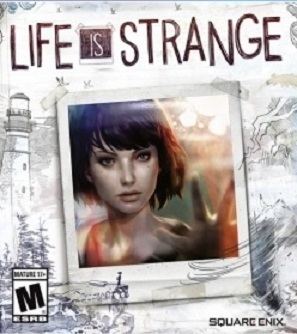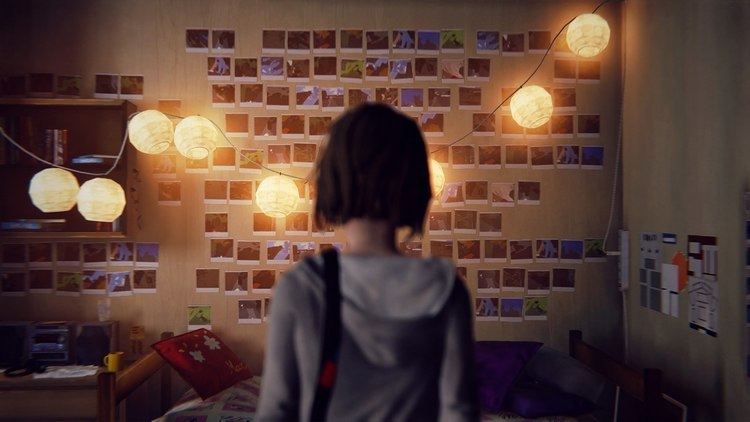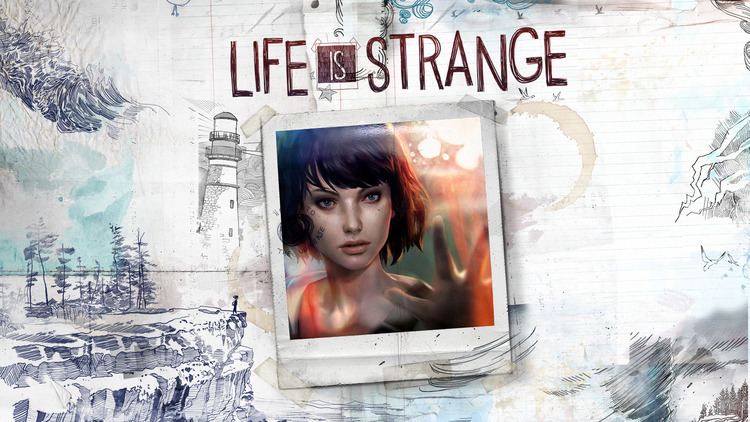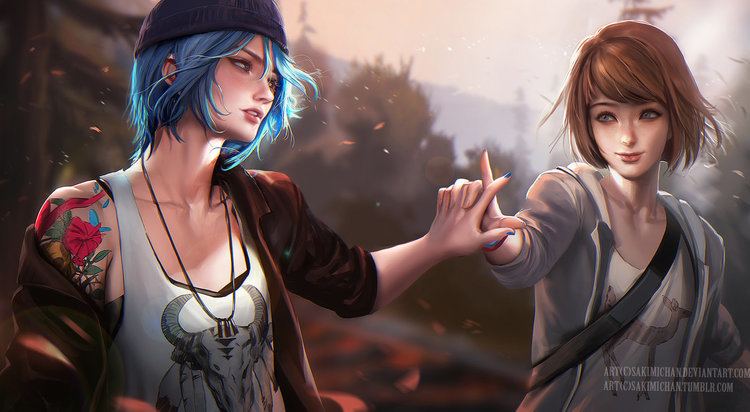9.2 /10 1 Votes9.2
4.8/5 Microsoft Initial release date 29 January 2015 | 10/10 Steam 8/10 GameSpot Producer(s) Luc Baghadoust Developer Dontnod Entertainment | |||||||||||||||||||||||||||||||||
 | ||||||||||||||||||||||||||||||||||
Director(s) Raoul BarbetMichel Koch Artist(s) Michel KochKenny LaurentAmaury Balandier Writer(s) Christian DivineJean-Luc Cano Awards BAFTA Games Award for Story Genres Graphic adventure game, Episodic video game, Interactive movie Platforms PlayStation 4, Xbox One, PlayStation 3, Xbox 360, Microsoft Windows, Macintosh operating systems, Linux Designers Sebastien Gaillard, Baptiste Moisan, Sebastien Judit Similar Interactive movie games, Other games | ||||||||||||||||||||||||||||||||||
Life is strange trailer
Life Is Strange is an episodic graphic adventure video game developed by Dontnod Entertainment and published by Square Enix. It is available for Linux, Microsoft Windows, OS X, PlayStation 3, PlayStation 4, Xbox 360 and Xbox One, and consists of five episodes released periodically throughout 2015.
Contents
- Life is strange trailer
- I can time travel life is strange episode 1 full gameplay
- Gameplay
- Plot
- Development
- Release
- Reception
- Sales
- Legacy
- References

The game's plot focuses on Maxine Caulfield, a photography student who discovers that she has the ability to rewind time at any moment, leading her every choice to enact the butterfly effect. After having foreseen an approaching storm, Max must take on the responsibility to prevent it from destroying her town. The player's actions will adjust the narrative as it unfolds, and reshape it once allowed to travel back in time. Fetch quests and making environmental changes represent the forms of puzzle solving in addition to using branching choices for conversation.

Development of Life Is Strange began in April 2013. It was formed with an episodic format in mind, for reasons both financial and creative. The developers conducted field research on the setting by travelling to the Pacific Northwest, and subverted known archetypes to make the characters. Player feedback influenced the adjustments made to the episodes. Story and character arc serve as the central point in the game rather than traditional graphic adventure tropes like point-and-click puzzles. The voice recording sessions took place in Los Angeles, California.

During its release, Life Is Strange received generally favourable reviews commending the character development, rewind game mechanic and tackling of taboo subjects. It won the BAFTA Games Award for Best Story, the Peabody-Facebook Futures of Media Award and The Game Awards' Games for Impact Award. Common criticisms included the slang that was used, poor lip-syncing in earlier episodes, and tonal inconsistencies in the story. It had sold one million digital copies by the end of July 2015. A digital series based on the game is being developed by Legendary Digital Studios and Square Enix.
I can time travel life is strange episode 1 full gameplay
Gameplay
Life Is Strange is a graphic adventure played from a third-person view. The mechanic of rewinding time allows the player to redo any action that has been taken. The player can examine and interact with objects, which enables puzzle solving in the form of fetch quests and making changes to the environment. Items that are collected before time travelling will be kept in the inventory after the fact.
The player can explore various locations in the fictional setting of Arcadia Bay and communicate with non-playable characters. Dialogue exchanges can be rewound while branching options are used for conversation. Once an event is reset, the details provided earlier are permitted to avail themselves in the future. In some instances, choices in dialogue will alter and affect the story through short or long-term consequences. For each one of the choices, something good in the short-term could turn out worse later.
Plot
Life Is Strange is set in the fictional town of Arcadia Bay, Oregon, and is told from the perspective of Maxine Caulfield (Hannah Telle), a twelfth grade student of Blackwell Academy, during the week of 7 October 2013. During photography class with her teacher Mark Jefferson (Derek Phillips), Max experiences a vision of a lighthouse being destroyed by a swelling tornado. Leaving for the restroom to regain her composure, she witnesses classmate Nathan Prescott (Nik Shriner) accidentally murder a girl. In a single, sudden effort, she develops the ability to rewind time and rescues the girl; her childhood friend Chloe Price (Ashly Burch). The two reunite and go for a walk at the lighthouse, where Max reveals to Chloe her capacity to travel back in time. It is established that the vision is rather the reckoning of a future event: a storm approaching the town. The next day, Max observes fellow student Kate Marsh (Dayeanne Hutton) being bullied for a viral video depicting her kissing several students at a party. It is implied that she was drugged, and Max suspects Nathan as the perpetrator. Meeting Chloe at the diner where her mother Joyce (Cissy Jones) works, they decide to experiment with Max's power at Chloe's secret scrapyard hideout. However, strain causes Max to have a nosebleed and faint. Chloe takes her back to Blackwell, but class is halted when everyone is called out to the courtyard. Kate commits suicide by jumping off the roof of the girls' dorm. Max manages to rewind and time stops unexpectedly as she reaches Kate, giving Max the opportunity to convince her to come down. Max ultimately resolves to uncover what happened to Kate and Chloe's missing friend Rachel Amber.
Max and Chloe break into the principal's office that night to investigate and enter the pool for a swim before evading David Madsen (Don McManus), head of security at Blackwell and Chloe's stepfather, and fleeing back to Chloe's place. The next morning, they sneak into the motorhome of Frank Bowers (Daniel Bonjour), drug dealer and friend of Rachel, and learn that Rachel was in a relationship with Frank and lied to Chloe about it, causing Chloe to storm off feeling betrayed. Max returns to her dormitory and examines a childhood photo of her and Chloe, but is suddenly transported to the day the picture was taken. Max prevents Chloe's father William (Joe Ochman) from dying in a traffic collision, which inadvertently creates an alternative reality where William is alive but Chloe has been paralysed from the neck down as a result of a collision in her own car. Max uses the photo to undo her decision and return to the present day, restoring Chloe's health. Continuing their investigation, Max and Chloe obtain clues leading them to an abandoned barn owned by the influential Prescott family. They discover a hidden bunker containing pictures of Kate and Rachel tied up and intoxicated, with Rachel being buried at Chloe's secret hideout. They hurry back to the scrapyard and find Rachel dead, much to Chloe's despair. Max follows Chloe at the school party to confront Nathan, believing he will target fellow student Victoria Chase (Dani Knights). They receive a text from Nathan threatening to destroy the evidence, returning them to the scrapyard. All of a sudden, the two are ambushed by Jefferson, who anaesthetises Max and kills Chloe with a shot to the head. Max is kidnapped and held captive in the "Dark Room", a place Jefferson has been drugging and photographing young girls to capture their innocence. Max escapes into a photograph and emerges back at the beginning in Jefferson's class. She alerts David, getting Jefferson arrested. Max is given the opportunity to go to San Francisco and have one of her photos displayed in an art gallery. She calls Chloe from the event, realising that, for all her effort, the storm has reached Arcadia Bay. Max teleports to the time she took the gallery photo, which eventually leads her to sojourn alternative realities as they devolve into a dreamscape nightmare. Max and Chloe finally return to the lighthouse and confront the fact that Max brought the storm into existence by availing herself of the time travel abilities in the first place. The only way to prevent it is for Max to go back to the beginning and allow Chloe to be killed by Nathan. Max must make a choice: sacrifice Chloe's life to save Arcadia Bay, or sacrifice Arcadia Bay in order to spare Chloe.
Development
Life Is Strange was Dontnod Entertainment's second title starring a female protagonist (the first being Remember Me). It was disclosed in a developer diary that, as with its first project, efforts were made by potential publishers to have a male protagonist put in place instead. Square Enix was the only publisher with no intention to change it. Dontnod co-founder Jean-Maxime Moris brought up the Gamergate controversy in the same context as an example of "a great debate to have", but put emphasis on that they were not using the issue to stand out from the rest.
The development of Life Is Strange was started in April 2013 with a team of 15 people, which expanded once collaborations with Square Enix commenced. The partnership with Square Enix occurred once Dontnod's initial sales pitch for a larger game was turned down and the developer mentioned what else they were working on. The game was originally codenamed What If but then retitled to distinguish itself from the film of the same name. Life Is Strange was born of the idea for the rewind mechanic, which the developer had already experimented on with their last game Remember Me. The lead character Max was created with the ability to rewind time to supplement this mechanism. The episodic format was chosen by the studio for creative reasons, financial restrictions and marketing purposes, allowing them to tell the story in its preferred slow pace. The Pacific Northwest was picked as the setting for the purpose of conveying a nostalgic and autumnal feel to the game. The development team visited the region, took photographs, looked at local newspapers and used Google Street View to make sure the environment was accurately portrayed.
It was decided early on that most of the budget be spent on the writing and voice actors. The original story was written in French by Jean-Luc Cano, and converted into a game script by the co-directors and design team. It was subsequently handed over to Christian Divine and Cano to be fine tuned in English. Story and character development were highlighted over point-and-click puzzles, making choice and consequence integral to how the narrative unfolds. Hannah Telle auditioned for Max Caulfield in July 2014 and was offered the part; Ashly Burch auditioned for both Max and her given role Chloe Price. The recording sessions were done in Los Angeles, California, with the French developer brought in via Skype.
Although it holds significant differences from Remember Me, the game addresses similar themes of memory and identity. Life Is Strange was specified as an analogue look at human identity in contrast to Remember Me, the digital view of the same theme. Running on an improved version of Unreal Engine 3, it makes use of the tools and special effects like lighting and depth of field engineered for Remember Me as well as subsequent advances. Visual effects like post-processes, double exposure and overlapping screen space particles were used as an artistic approach to be displayed while the lead character rewinds time. The textures seen in the game were entirely hand painted, adapted to achieve what art director Michel Koch called "impressionistic rendering". Elements were adjusted based on player feedback, with influences like The Walking Dead, Gone Home1 and Heavy Rain in mind. The Catcher in the Rye was an additional source of inspiration, whose protagonist Holden Caulfield shares a surname with Max, the game's lead. The characters were created using known archetypes, at first to establish an entry point for the player, and then to subvert them. For the sake of serving the realism, the supernatural elements were designed as a metaphor for the characters' inner conflict, and experts were consulted to tackle the subject of teen suicide.
The score was composed by Jonathan Morali of the band Syd Matters. Inspired by modern indie folk music, the soundtrack was intended to inform the mood of the game. The music contains a blend of licensed tracks and composed pieces. Featured artists include José González, Mogwai, Breton, Amanda Palmer, Brian Viglione, Bright Eyes, Message to Bears, Local Natives, Syd Matters, Sparklehorse, Angus & Julia Stone, alt-J, Mud Flow and Foals.
Release
Square Enix and Dontnod announced Life Is Strange on 11 August 2014. The episodes were released digitally on PC via Steam, PlayStation 3 and PlayStation 4 via PlayStation Network, and Xbox 360 and Xbox One via Xbox Live between 30 January 2015 and 20 October 2015. In November 2014, the publisher expressed interest in having physical copies released of the game, but at the time added that they were 100% focused on the digital release. One year later, the retail edition was set to be released for the PC, PS4 and Xbox One in North America on 19 January 2016 and in Europe on 22 January 2016; the limited edition featured an artbook, the soundtrack, score and a director's commentary.
A Japanese version was released for Microsoft Windows, PlayStation 3 and PlayStation 4 on 3 March 2016. Feral Interactive was tasked with porting Life Is Strange for OS X, released on 16 June 2016, and Linux, released on 21 July 2016. That same day, the first episode was made indefinitely available for free on Linux, PC, OS X, PS3, PS4, Xbox 360 and Xbox One.
Reception
Life Is Strange received generally favourable reviews, having aggregated a Metacritic score of 85/100 on PlayStation 4 and Xbox One. While criticised for its lip-syncing and use of dialogue, critics notably lauded the character development and time travel component, suggesting that there should be more games like it. Eurogamer thought of it as "one of the best interactive story games of this generation" and Hardcore Gamer declared it the sleeper hit of 2015. Life Is Strange garnered over 75 Game of the Year awards and listings.
Kevin VanOrd of GameSpot called Episode 1: Chrysalis "an involving slice of life that works because its situations eloquently capture a peculiar early-college state of mind", while Game Informer's Kimberley Wallace stated that she found the tackling of "subjects that are usually taboo for video games" impressive. Destructoid's Brett Makedonski noticed that the episode's strongest characteristic was exploration—both "self- and worldly". However, Mitch Dyer of IGN wrote that the story was ultimately obstructed by its "laughable" script and "worse performances". In response to Episode 2: Out of Time, Polygon's Megan Farokhmanesh echoed the view that the emphasis on self-exploration had considerable impact on the enjoyment of the game. Critics opined that the ending was an "emotional high point" and that it brought meaning to the choices from both the first and second episodes. Writing for USgamer, Mike Williams disparaged the pacing of Episode 2: Out of Time as "slower and less exciting" than that of episode one.
Episode 3: Chaos Theory was thought by Adnan Riaz of Hardcore Gamer to be a dramatic improvement that presented a "thrilling, poignant, fascinating and ... enticing" narrative whose outcome from past decisions also added a sense of realism. Additionally, Peter Paras of Game Revolution complimented the character beats, particularly the development of Chloe Price, who he said "really comes into her own as [a] fully-formed character". Though GameSpot's Alexa Ray Corriea said that the fetch quests interfered with its emotional quality, the episode built up to a "killer cliffhanger" according to Farokhmanesh. GameZone's Matt Liebl deemed Episode 4: Dark Room "easily the most emotional episode" and said that the mystery of Rachel Amber had done a "tremendous job in keeping us hooked". Tom Hoggins of The Telegraph regarded the developer's venture into subjects like social division, online bullying, parental conflict and suicide as "bold". Criticism was directed at its "cheap ways" of progressing the plot—character inconsistency and superfluous shock value—resulting in tonal problems, with the episode's puzzles and relationships given more approval. The final episode, Polarized, was commended for having offered a "fitting conclusion" to the coming of age story of Max Caulfield and the relationship between the two leads was similarly noted as having been carried out successfully. One stealth sequence was described as "tedious" and "out-of-place" while other aspects inhabiting the same course of events were favoured. Reviewers were essentially divided on the ending, citing the episode's subtitle as something that mirrored their own feelings toward it.
Sales
The first episode was ranked fifth among the best selling PlayStation 3 and PlayStation 4 video games of February 2015. Life Is Strange reached one million sales in July 2015, having accumulated over 1.2 million unique players worldwide; the attach rate to units between the complete season and season pass proved to be "extremely strong", divulged Square Enix. The retail edition made seventh place in the top ten UK game sales chart for the week ending 23 January 2016. Life Is Strange was one of the top 100 best-selling games on Steam in 2016.
Legacy
After Life Is Strange achieved financial and commercial success, Dontnod Entertainment started to become more prominent in the video game industry; publishers would pursue the studio for the first time, where once Dontnod had to solicit the publishers themselves.
It was announced in July 2016 that Legendary Digital Studios and Square Enix, in conjunction with dj2 Entertainment, would be adapting Life Is Strange as a digital series. Legendary revealed that, at the time of the announcement, they were meeting with potential writers for the series adaptation, which will be set in Arcadia Bay.
